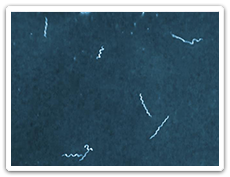Lyme Disease
 Lyme disease is caused by a bacterium transmitted in North America by the bite of an infected blacklegged tick (Ixodes scapularis) or western blacklegged ticks (Ixodes pacificus). Common symptoms include a red-expanding rash (Erythrema migrans), headache, fever, fatigue, fever and chills. If left untreated Lyme disease infection can cause joint, heart and nervous system complications. Lyme disease can be successfully treated with antibiotics, particularly when diagnosed early. Risk of infection can be lowered by preventing tick bites.
Lyme disease is caused by a bacterium transmitted in North America by the bite of an infected blacklegged tick (Ixodes scapularis) or western blacklegged ticks (Ixodes pacificus). Common symptoms include a red-expanding rash (Erythrema migrans), headache, fever, fatigue, fever and chills. If left untreated Lyme disease infection can cause joint, heart and nervous system complications. Lyme disease can be successfully treated with antibiotics, particularly when diagnosed early. Risk of infection can be lowered by preventing tick bites.
Image Content Provider: Adam Replogle US CDC PHIL
Symptoms
Symptoms typically appear 3 – 30 days following the bite of an infected blacklegged tick. Many people will develop a characteristic expanding rash (Erythema migrans) which is neither itchy, nor tender. Other early symptoms of Lyme disease are non-specific and may include: headache, fatigue, chills, fever, muscle aches, joint pain, stiff neck or swollen lymph nodes. If left untreated infection can spread to the joints, heart and nervous system. Additional symptoms may be seen in individuals with exposure to Lyme disease in Europe.
Blacklegged ticks can also transmit other infections, such as Anaplasmosis and Babesiosis. Co-infection with either of these may result in symptoms that are more severe and/ or prolonged.
Causes
Lyme disease is a tick-borne infection caused by the bacterium, Borrelia burgdorferi. In North America the bacteria is normally maintained between blacklegged ticks (Ixodes scapularis), small mammals, such as mice, birds and deer. Humans can become infected when bitten by an infected blacklegged tick. The highest risk period, May – July coincides with the peak activity of blacklegged tick nymphs.
Treatment
Early diagnosis and treatment of Lyme disease is important and can help prevent late Lyme disease. Individuals should contact their health care provider if they think they may have symptoms of a tick-borne disease.
Antibiotic treatment is typically started based on a physician’s clinical suspicion of infection. Lyme disease can be successfully treated with a 2 – 3 week course of antibiotics. This treatment is most successful when started early.
A small percentage of patients may continue to experience non-specific symptoms following successful treatment. This condition is known as post-treatment Lyme disease syndrome and may include symptoms such as sleep disturbance, fatigue, muscle or joint pain and mental confusion (inability to think clearly).
Prevention
Restricting exposure to potentially infected blacklegged ticks is the key to preventing Lyme disease.
The risk of encountering potentially infected blacklegged ticks is greatest in blacklegged tick risk areas where surveillance has revealed established tick populations. Outside of these areas the likelihood of encountering blacklegged ticks is significantly lower. Blacklegged ticks are most commonly found in wooded or forested areas, or along the fringes of such areas, as these locations provide them with a suitable humid habitat in which to survive. When active in these areas it is important to adopt preventative measures such as:
- Use trails, whenever possible, and stay to the centre of hiking trails or paths,
- Wear light coloured long pants and long sleeved shirts,
- Tuck in clothing (pants and socks) to create a barrier,
- Use an appropriate tick repellent.
Perform a thorough tick check after spending time outdoors inspect yourself, your children and your pets for blacklegged ticks and remove any found as soon as possible. Do not stop if you find one tick, as there may be more. Bathing soon after coming indoors is a good way to find any ticks. Be sure to check clothing and items such as backpacks which may have come into contact with vegetation as well. Finding and removing ticks in a timely manner can significantly reduce the likelihood of disease transmission.
Manitoba Health Resources
For the Public
Materials can be requested by visiting Health Information Resources and completing the attached form.
- Click here to access the eTick platform, including links to download the free mobile eTick app in both the Google Play or App stores.
- Tick-borne Diseases & Children

Tips for parents, guardians and those working with children to reduce the potential for transmission of tick-borne diseases. - Tick Bite Prevention, Tick Checks and Tick Removal Postcard

Quick reference tool with tips for tick-bite prevention, tick checks and tick removal. - Tick Bite Prevention and Tick Removal – Quick Reference Card

Wallet sized card with tick-bite prevention and tick removal tips. - Landscape Tips to Reduce Ticks

Quick reference tool with tips to make yards less welcoming to ticks and their hosts (ex. mice and deer).
For Health Care Providers
- Tick-borne disease Quick Reference Guide for Health Care Providers NEW
- Tick Collaborative Care Service (TiCCS) – provincial care service for diagnosing and managing cases of possible late Lyme and/ or other emerging tick borne diseases (referral required)
- Lyme disease risk areas in Canada – Public Health Agency of Canada
- Tick-borne Infections in Manitoba - Update for Health Care Providers
May 20, 2021 - Tick-borne Disease Clinical Case Report Form

- Lyme Disease Communicable Disease Management Protocol

- Archived updates related to Tick-Borne diseases can be found here
Other Resources
- Lyme Disease – Public Health Agency of Canada
- Tick-borne diseases of the United States – Reference Manual for Health Care Providers (U.S. Centers for Disease Control and Prevention)
- Additional resources - Emerging Tick-Borne diseases, surveillance, prevention and travel
Communicable Disease
Control (CDC) Health Links – Info Santé |



